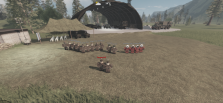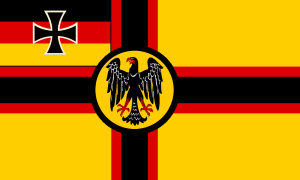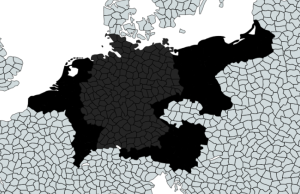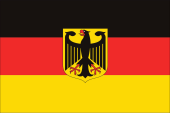Germany
| ||||||||||||||||||||||||||||||||||||||||||
Germany, officially known as the Federal Republic of Germany, is a country located in Central Europe. With a rich cultural heritage and a pivotal role in European history, Germany is renowned for its contributions to art, science, and technology. It boasts diverse landscapes, from the Bavarian Alps to the Rhine River Valley. Home to approximately 83 million people, Germany is a federal parliamentary republic consisting of 16 states. It is one of the world's leading industrialized nations, known for its strong economy and innovative advancements. Berlin serves as the capital and largest city, embodying Germany's vibrant spirit and cosmopolitan character
History
Founding
The beginning of Germany takes us back to mid January 2024. It was first called "Berlinia" which changed a lot in the History of Ro Nations. The Nation was split up into 3 Nations at first. Berlinia was assigned to the south of Germany without much complications. The German Bundeswehr back then was at its more Golden age, because at the moment they were recruiting a lot of Soldiers. The Airforce was very well established from the past German Reich. The Navy was took away from us because of Complications with Northern Germans. From then on the Germans sweared to Reunite all Germanic People.
Berlinia
Germanys first ever Established Goverment was Berlinia. Berlinia was a well designed and armed State at the time. The 2 other Germanies had a Problem with Berlinia and sind a mutual Pakt to attack Berlinia and Berlia only. But Berlinia was Planning their own ways and decided to plan a massive offensive to Reunite Germany.
The Three-German-Crisis

The German Three State Crisis was an event from March 23rd to April 2nd in which Germany was divided between Berlinia, German Democratic Republic and Germany[1]. Germany was split into 3 Nation. The Three Germanies had one Vision: Uniting Germany under their Great Government. The Two Germanies North of Germany had intel on the Berlinian Armed Forces and were able to inter reasonable strength. So they formed a coalition against Berlinia to destabilise them and decide on their own after Berlinia was gone. Berlinia, knew this was happening, so they planned an offensive called "Operation Steiner". The Operation was a campaign of, first of Bombing the other Germanies to hell with their airforce. The launching of a massive offensive with large parts of the Berlinian Army in total over 45 soldiers were mobilised making it one of the largest operations done by a single nation within RoNations. The goal was to occupy Germany under the Berlinian regime which succeeded to an extent. After the first Bombing campaigns the Northern Germanies surrendered. The GDR (German Democratic Republic) and German Federal Republic were both annexed, the leaders of the German Federal Republic were able to strike a deal combining the two states resulting in the creation of the Großdeutsches Reich
The Recruitment and rebuilding of Germany

The Government announced a significant investment in the modernization and strengthening of their armed forces. In light of the increase in soldiers in the Bundeswehr, the government has decided to allocate 100 billion Reichs Mark to the military. A substantial portion of these funds were directed towards the reworking and enhancement of their tank fleet produced in the Rheinmetall factories. The modernization of their tanks encompasses several crucial aspects. Firstly, comprehensive improvements to the armour were made to enhance protection capabilities against modern threats. Secondly, the integration of advanced sensor technologies into the armor were carried out to enhance situational awareness and targeting capabilities. Additionally, the Government planed further enhancements and investments in the Bundeswehr to increase its performance and operational readyness. This included the modernization of equipment and infrastructure, the augmentation of personnel strength, and the improvement of training programs. These investments underscore our commitment to the security and defense of our nation, as well as our dedication to providing our armed forces with the best possible support and equipment.
The Germanic Flag

The Government wanted to announce a change to the Flag of the German People, because "it looks like the past" - Ministry of Defense, Nicombat
"It is with immense pride and profound significance that we declare the unification of Germany and the country formerly known as Berlinia. After decades of separation, division, today marks a triumph of unity, reconciliation, and the collective will of our people. With unwavering determination, leaders from both sides have come together to build bridges, dissolve barriers, and embrace a shared future. In light of this momentous occasion, we announce the adoption of a new name for our united nation: Großdeutsches Reich. This name reflects not only our historical heritage but also our commitment to inclusivity and strength through unity." - Strauß
The Future of Germanic People
Germany had new plans for the future of their People: Uniting every Germanic country under their regime

The Great Chancellor "keksdose_lp" had brought Germany this far: ,,may as well keep going" he said. He launched a massive campaign to annex every Germanic State, City and Province to then claim the name
"Großdeutsches Reich". He had planned lots of Reforms to his country including Govermental and Diplomatic ones. keksdose_lp had a great vision ahead, a great Germany. He ordered all his men to simply ask
unclaimed Provinces to join his "Reich". A lot of people loved the Idea, but a lot also didn't..
"For too long, these lands have remained stateless, neglected and devoid of the cultural and historical heritage that binds them to our nation. With this bold step, we reclaim what is rightfully ours and reaffirm our commitment to the preservation and advancement of Germanic identity and values. The annexation of these territories represents a historic opportunity to reunite scattered communities and revitalize regions that have long been disconnected from the German nation. It is a testament to our unwavering resolve to safeguard the interests and well-being of all Germans and Germanics, wherever they may reside. As we embark on this journey of reunification and integration, we call upon all citizens to embrace our shared heritage and extend a warm welcome to our fellow countrymen and women who will soon join us as full members of our society. The German Reichsregierung is fully committed to ensuring a smooth and peaceful transition for all affected regions and communities. We will work tirelessly to provide the necessary support and resources to facilitate their integration into the fabric of our nation. Let us stand united in this historic endeavor, as we embark on a new chapter of German greatness and solidarity." - Ministry of Defense, Nicombat to be continued
- ↑ Then the Federal Republic of Germany
The Germanic Question
The Germanic Question in the Federal Republic of Germany pertains to the intricate socio-political dynamics arising from the historical legacy of the Greater German Empire and its subsequent transformation into the modern Federal Republic. Rooted in the diverse ethnic and cultural composition of German-speaking regions, this issue encompasses the complexities of minority rights, cultural preservation, and national identity within the Federal Republic's borders.
Regional and International Implications
Germany's handling of the Germanic Question also reverberates beyond its borders, influencing relations with neighboring countries harboring significant German-speaking populations. Countries such as Austria, Switzerland, and parts of Eastern Europe closely monitor developments within the Federal Republic, seeking to safeguard the rights and representation of their respective German-speaking minorities.
The Germanic Question remains a significant and evolving aspect of German politics and society, reflecting the enduring legacy of the Greater German Empire and the complexities of managing ethnic and cultural diversity within the Federal Republic of Germany. By addressing these challenges with sensitivity and pragmatism, Germany seeks to forge a path forward that respects the rights and identities of all its citizens while maintaining national unity and cohesion.
Modern German Flag
The modern German flag, commonly referred to as the "Bundesflagge und Handelsflagge der Bundesrepublik Deutschland" (Federal Flag and Merchant Flag of the Federal Republic of Germany), serves as the national flag and ensign of the Federal Republic of Germany. It consists of three horizontal stripes of equal width, with the colors black, red, and gold from top to bottom.
Historical Evolution
The origins of the black, red, and gold colors can be traced back to the early 19th century and the German student movement known as the "Burschenschaften." These colors were associated with the quest for German unity and freedom during the Napoleonic Wars and later became emblematic of the democratic and liberal aspirations of the German people.
The flag's design underwent several iterations throughout German history, particularly during periods of political upheaval and change. Notably, the Weimar Republic (1919–1933) adopted a similar tricolor flag with black, red, and gold stripes, symbolizing the principles of democracy and the aspirations for a unified and democratic Germany.
Adoption of the Modern Flag
Following the establishment of the Federal Republic of Germany, the black, red, and gold tricolor flag was officially readopted as the national flag. The design was enshrined in the Basic Law of the Federal Republic of Germany (Grundgesetz) as the official flag of the newly formed state.
Symbolism
The colors of the modern German flag hold symbolic significance:
- Black: Historically associated with the Prussian monarchy, the color black represents determination, strength, and resilience.
- Red: Symbolizing the blood shed in the pursuit of freedom and unity, the color red reflects the values of courage, sacrifice, and solidarity.
- Gold: Representing the golden future of a united and prosperous Germany, the color gold embodies hope, optimism, and enlightenment.
Together, these colors embody the democratic and liberal ideals of the Federal Republic of Germany and its commitment to freedom, unity, and prosperity.
Usage
The modern German flag is prominently displayed throughout the country on public buildings, government institutions, and official ceremonies. It also serves as the national ensign for German-registered ships and aircraft, symbolizing Germany's presence and identity on the international stage.
The modern German flag, with its distinctive black, red, and gold tricolor design, stands as a powerful symbol of the Federal Republic of Germany's democratic values, historical legacy, and national identity. Embraced by Germans both at home and abroad, the flag embodies the principles of freedom, unity, and prosperity that define modern Germany.
German Armed Forces
The German Armed Forces, known as the "Bundeswehr," serve as the unified military forces of the Federal Republic of Germany. The Bundeswehr was formed with the primary objective of safeguarding national security and contributing to international peacekeeping efforts.
The German armed forces are divided into 3 branches:
- German Army: The ground component of the Bundeswehr, the Army is responsible for land-based military operations, including infantry, armored, and mechanized units. It plays a vital role in homeland defense, as well as international peacekeeping missions.
- German Navy: The naval component of the Bundeswehr, the Navy is tasked with protecting German maritime interests, ensuring sea lines of communication, and conducting maritime security operations. It operates a variety of vessels, including frigates, submarines, and support ships.
- German Airforce: The aerial component of the Bundeswehr, the Air Force is responsible for air superiority, air defense, and aerospace operations. It operates a diverse fleet of aircraft, including fighter jets, transport planes, and helicopters, and plays a crucial role in both national defense and international operations.
- Armed Forces Base: The Joint Support Service provides essential logistical, administrative, and medical support to all branches of the Bundeswehr. It ensures the effective coordination and integration of resources and capabilities across the entire military spectrum.
Rationale for Multiple Branches
The division of the German Armed Forces into multiple branches reflects the need for specialized capabilities and expertise to address a wide range of security challenges effectively. Each branch is optimized for its respective domain of operations, whether on land, at sea, or in the air, and collaborates closely with the others to achieve synergistic effects and comprehensive defense.
Furthermore, the structure of the Bundeswehr enables flexibility and adaptability in responding to evolving security threats and changing operational environments. By maintaining distinct branches with complementary roles and capabilities, the German Armed Forces are better equipped to fulfill their mandate of defending the nation's sovereignty, protecting its interests, and contributing to international security and stability.
The German Armed Forces, organized into multiple branches, stand as a cornerstone of national defense and security for the Federal Republic of Germany. Through their collective efforts and commitment to excellence, the Bundeswehr remains prepared to meet the challenges of the 21st century and uphold the principles of peace, freedom, and democracy at home and abroad.

